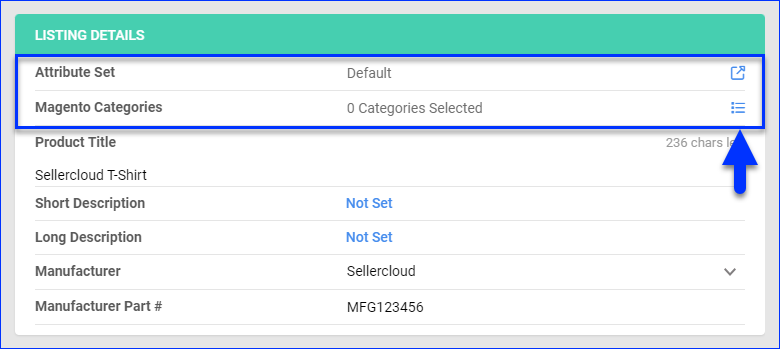Overview
The Magento Account Integration allows you to manage your Magento listings directly from the Sellercloud interface. You can post and manage multiple listings, update inventory quantities and pricing, assign categories, and update any Magento Product Attribute. Listings on Magento can be updated both automatically and manually. Refer to the Related Client Settings section of this article for a list of all Client Settings that may impact how Magento listings management works in Sellercloud.
Prepare Products for Magento
Before posting a product to Magento, you must make sure it’s ready by enabling it and configuring any properties you want to update.
Individually
To enable a single product for Magento:
- Go to the Product Details Page.
- Click Toolbox and select Magento > Magento Properties.
- Click Edit.
- Check Magento Enabled.
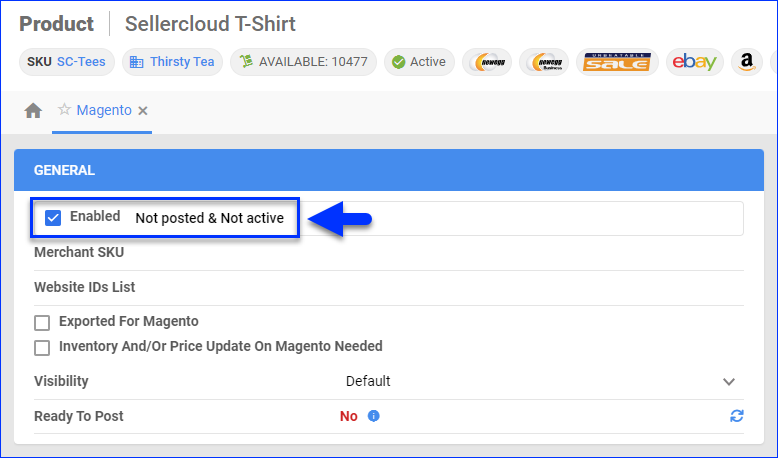
- Although not required for posting, it’s best to also:
- Configure the product’s Magento Properties and Categories.
- Select an Attribute Set to update any additional Magento Attributes.
If the Client Setting Allow To Send Empty Attributes To Magento is disabled, you will be required to enter Attributes for Magento products before posting them.
- Click Save.
In Bulk
To enable products for Magento without configuring additional settings:
- Go to Catalog > Manage Catalog.
- Select the products you want to update.
- Click the Actions icon in the bottom-right corner, and select Enable/Disable For Channel.
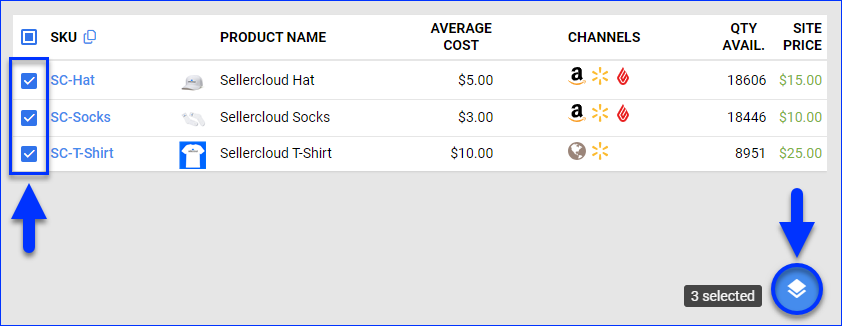
- Check Magento and click Update.
You can do a Bulk Product Update to both enable your products for Magento and configure their Magento Properties in bulk. Refer to the table below for a list of Magento properties:
- MagentoEnabled – Enable Sellercloud to send product information and updates to Magento. With Variation Products, the parent and all the children must be Magento Enabled. The expected values are True or False.
- MagentoTitle – The product’s name on Magento.
- ShortDescription – The product’s short description, same as the field on the Product Details Page.
- LongDescription – The product’s short description, same as the field on the Product Details Page.
- MagentoProductDescriptionShort – The product’s short description specifically for Magento. Enabled with a Client Setting called Enable Magento Specific Product Description.
- MagentoProductDescriptionLong – The product’s long description specifically for Magento. Enabled with a Client Setting called Enable Magento Specific Product Description.
- MagentoViewURL – The URL assigned by Magento.
- ExportedForMagento – Mark a product as exported for the Magento site. The expected values are True or False.
- ExportedForMagentoOn – The date of product export for the Magento site.
- MagentoAttributeSetID – The ID of an attribute assigned to the product through the attribute set.
- MagentoAttributeSetName – The name of the product’s assigned Magento attribute set.
- MagentoCategoryList – Reflects the Magento Category ID. When adding multiple categories, separate them with commas.
- MagentoFreeShippingEnabled – Enables free shipping for Magento. Expected values are True or False.
- Magento_AllowBackOrder – Enter True to display the product on Magento even if it is out-of-stock, allowing it to be purchased in Backorders.
- MagentoMinQtyForCart – The minimum quantity that can be purchased.
- MagentoMinQtyForCartUseGlobal – Use the default minimum quantity for the cart configured on your company’s Magento Account Settings.
- MagentoMaxQtyForCart – The maximum quantity that can be purchased.
- MagentoMaxQtyForCartUseGlobal – Use the default maximum quantity for the cart configured on your company’s Magento Account Settings.
- MagentoQtyToMakeOutOfStock – The threshold quantity under which the product will be marked as out of stock.
- MagentoQtyToMakeOutOfStockUseGlobal – Use the default setting for out-of-stock quantity configured on your company’s Magento Account Settings.
- MagentoSpecialPrice – A special discounted price for the selected product.
- MagentoSpecialPriceFromDate – The first date of the special price promotion.
- MagentoSpecialPriceToDate – The last date of the special price promotion.
- MagentoTaxClass – The product’s tax setting: Global, None, Taxable Goods, or Shipping. Select Shipping if you charge additional taxes on shipping.
- MagentoBaseImage – The main image you see on the product page, usually around 700×500. It can be seen in even larger sizes if you click the image and browse the full-screen gallery.
- MagentoSmallImage – This version of the image is used on pages with multiple products, such as most homepage, category, and search results layouts. It’s also used for small boxes on product pages, such as up-sells and cross-sells. A normal size for this image is around 250×250.
- MagentoThumbnailImage – This image is often seen at the bottom of the product page and in the shopping cart and is usually around 100 pixels high and 100 pixels wide.
- ProductChannelRestricted_Magento – Restrict the product to exclude it from posting, updating, and both inventory and pricing feeds or unrestrict it to send updates.
Categories
After creating Categories in your Magento Admin portal, you can download them to Sellercloud automatically or manually. This allows you to assign Magento categories to products from Sellercloud.
Download Automatically
To download Magento categories to Sellercloud automatically:
- Go to Company Settings.
- Click Toolbox and select Magento > General Settings.
- Click Edit.
- In the Controls panel, check Enable Automatic Category Sync.
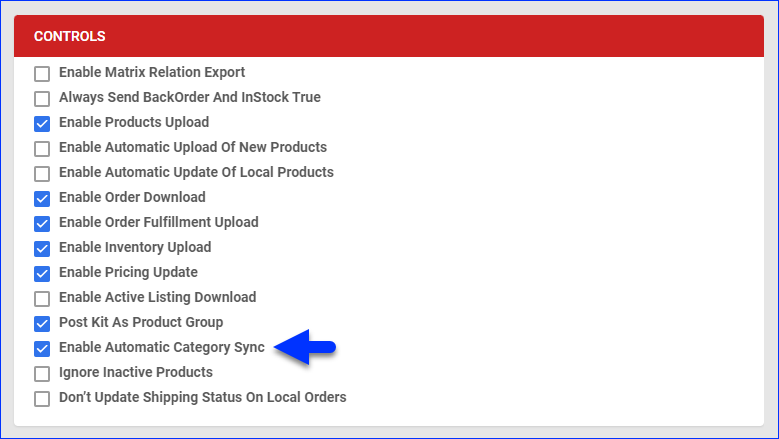
- Click Save.
Download Manually
To download Magento categories to Sellercloud:
- Go to Company Settings.
- Click Toolbox and select Magento > Categories.
- Click Re-Download all categories.

Assign Individually
To assign categories to a single product:
- Go to a Product Details Page.
- Click Toolbox and select Magento Properties.
You can also open the Magento Properties page by clicking the Magento icon at the top of the Product Details Page or by clicking the Magento icon next to a product on the Manage Catalog page and then selecting the pencil icon. - Click Edit.
- In the Listing Details panel, click the icon to the right of Magento Categories.
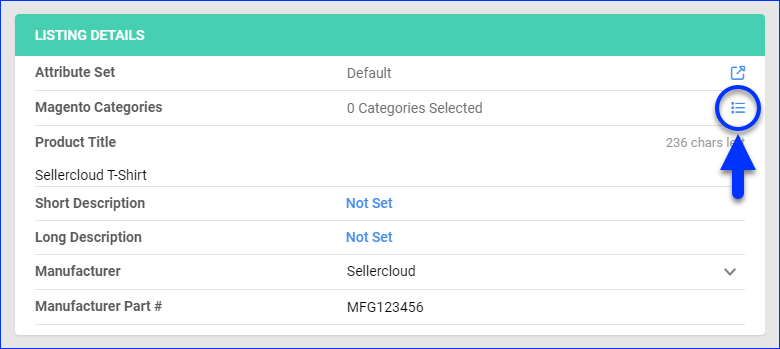
- Select the categories to assign and then Save.
- Click Save in the top right.
Assign In Bulk
To bulk-assign Magento categories to products:
- Go to Company Settings.
- Click Toolbox and select Magento > Categories.
- Click Export to Excel.

- Open the spreadsheet to find the numerical Category IDs of the categories you want to assign to products.
- Follow the steps to Bulk Update Products and add the column header MagentoCategoryList to your template.
- Enter the Category IDs under the MagentoCategoryList header. To add a product to multiple categories, enter comma-separated Category IDs.
Post Products on Magento
You can post products to Magento individually or in bulk.
Individually
To post a single product to Magento:
- Go to the Product Details Page.
- Click Toolbox and select Magento Properties.
- Click Actions and select Post Product on Magento.
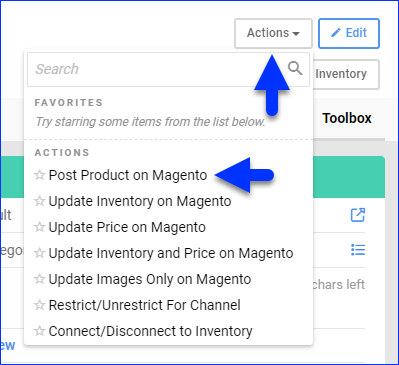
In Bulk
To post multiple products to Magento:
- Go to Catalog > Manage Catalog.
- Select the products you want to update.
- Click the Actions icon in the bottom-right corner, and select Launch on Channel.
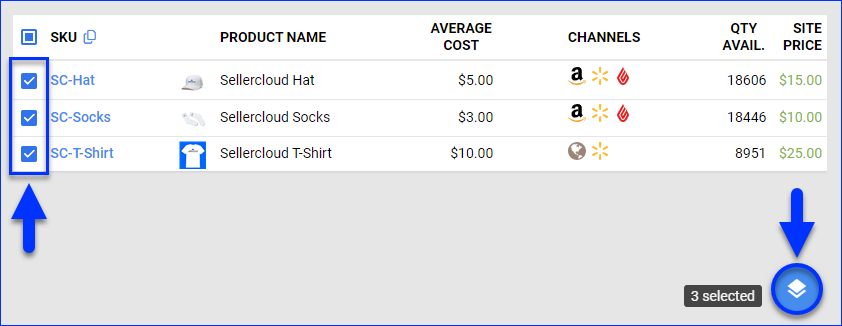
- Select Magento and click Launch.
- The task will be linked to a Queued Job. Once processed, the update will be sent to Magento.
Grouped Products
Grouped Products on Magento are bundles of similar or related products displayed on a single page. In Sellercloud, you use Kit Products to post Grouped Products.
To post Sellercloud kits as Grouped Products on Magento, first, you must post each kit component individually and then post the kit parent. On the Magento admin portal, the kit components will appear under the kit parent’s Associated Products tab.
To post Grouped Products, you must enable the required settings:
- Go to Company Settings.
- Click Toolbox and select Magento > General Settings.
- Click Edit.
- In the Credentials panel, check Enable Plugin For Inventory Management.
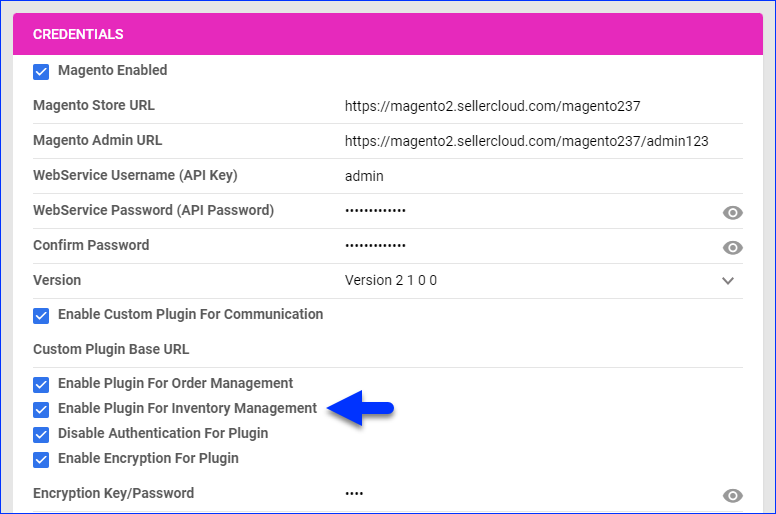
- In the Controls panel, check Post Kit As Product Group.
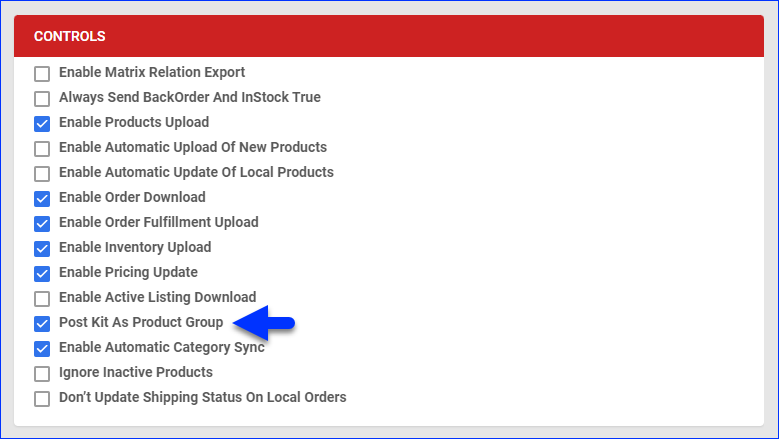
- Click Save.
Update Magento Listings
Sellercloud automatically updates product prices and inventory on a regular basis to help keep your Magento listings up-to-date You can update pricing, quantity, and other product information both automatically and manually.
Automatically
To initiate regular automatic Magento listing updates:
- Go to Company Settings.
- Click Toolbox and select Magento > General Settings.
- Click Edit.
- In the Controls panel, check:
- Enable Automatic Upload Of New Products to update all Magento-enabled products that have been modified within the last 24 hours, including product properties, categories, and Attributes.
MagentoSyncService must be enabled for this workflow! Contact Sellercloud Support to confirm if this service is installed on your server.
- Enable Inventory Upload to update the available inventory quantities.
- Enable Pricing Update to update the pricing.
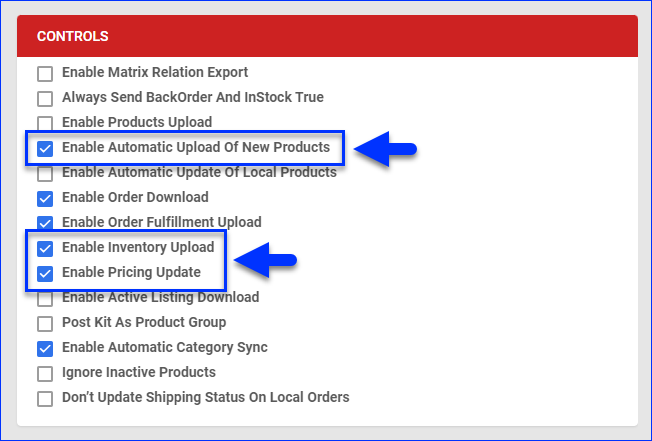
- Enable Automatic Upload Of New Products to update all Magento-enabled products that have been modified within the last 24 hours, including product properties, categories, and Attributes.
- Click Save.
Manually
Update listings manually to ensure changes in Sellercloud are pushed instantly. You can do this either individually or in bulk.
To update Magento listings individually:
-
- Go to the Product Details Page.
- Click Toolbox and select Magento Properties.
- Click Actions and select from these actions:
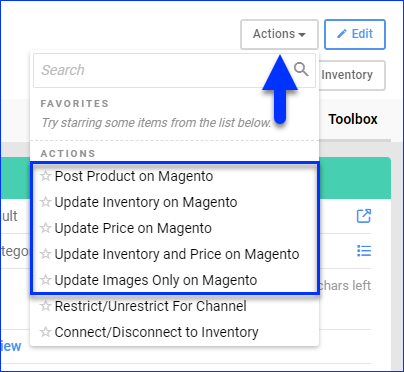
- Post Product on Magento – Completely update the product on Magento, including all product properties, categories, and Attributes.
- Update Inventory on Magento – Update the inventory on Magento based on the available quantity in Sellercloud.
- Update Price on Magento – Update the price on Magento based on the price configured in Sellercloud.
- Update Inventory and Price on Magento – Update both the inventory and price on Magento based on the data in Sellercloud.
- Update Images Only on Magento – Update the product images on Magento based on the Images set in Sellercloud.
To update Magento listings in bulk:
- Go to Catalog > Manage Catalog.
- Select the products you want to update.
- Click the Actions icon in the bottom-right corner, and select:

- Launch on Channel – Completely update the selected products on Magento, including all product properties, categories, and Attributes.
- Update Inventory on Channel – Update the selected products’ inventory on Magento based on the available quantities in Sellercloud.
- Update Prices on Channel – Update the selected products’ prices on Magento based on the prices set in Sellercloud.
- Update Images On Channel – Update selected products’ images on Magento based on the Images set in Sellercloud.
Related Client Settings
The following Client Settings related to Magento listings management are available:
- Enable Magento Merchant SKU – If enabled, a field called Merchant SKU will appear on the Magento Properties page of a product. When we communicate with Magento about inventory or orders, we will first examine the value in this field to try to match a listing to your item in Sellercloud. We will only check the Sellercloud SKU after this field is empty or incorrect.
- Enable Magento Specific Product Description – If enabled, you will be able to enter a unique Short Description on the Magento Properties page of a product; If disabled, we will copy the short description from the Short Description field on the Product Details Page automatically.
- Allow Shadow Products Posting Over Magento – If this setting is enabled, you will be able to list Shadow Products on Magento.
- Allow To Send Empty Attributes To Magento – If enabled, it will not be required for you to fill in Attributes for Magento products to list them, otherwise, we will return an empty attribute error message.
- Create Magento Kit Product As Simple Product – If enabled, Kit Products will not be created as Grouped Products when you use the Post to Magento or Launch on Channel actions.
- Display Variation Items Individually On Magento – If enabled, we will push Variation Products to Magento as unique single listings instead of one product with different variations.
- Do Not Send Inactive Products Inventory To Magento – If enabled, we will send an inventory of zero for a Magento product if you mark it as Inactive.
- Do Not Update Images On Magento – If enabled, we will not send Product Images to Magento when you use Post on Magento for a single product or Launch on Channel for products in bulk.
- Post Matrix Child Images to Magento – Control if the Product Images of kit components will be posted on Magento.
- Allow to send Matrix Parent price and inventory to Magento – Enable to update the available inventory and the price of variation parents when updating Magento listings. By default, only variation child products are updated.
- Send ListPrice To Magento – If enabled, we will send the Manufacturer’s Suggested Retail Price (MSRP) as the listing price for Magento products when you use the Update Price on Magento or Update Price on Channel actions. The MSRP field for Magento in Sellercloud is called Standard/List Price.
- Use EBay Prices And Shipping For Magento – If enabled, and you update the values in the Retail Price and Shipping Weight fields on the eBay Properties page of a product, we will automatically apply the same values to the Price and Shipping Weight fields on the Magento Properties page.
- Allow Zero Price Items For Magento Order – Allows Magento orders with products with a price of $0. You will also be able to ship these orders as the channel supports free item sales.
- Allow To Send Zero Price To Magento – By default, if a channel price is not available, we will take the Site/Retail Price from the Product Details Page and send it instead to prevent $0 feeds. If this setting is enabled and you have not set a Magento price, we will not consider the Site/Retail Price and still send $0 since the channel supports free item sales.
- Allow Zero Price Kit Child For Magento Order – If enabled, we will allow Magento orders with $0 price kit components so that you can sell free Kit Products.
- Do Not Send BackOrder Tags To Magento – If enabled, we will not send Backorder information to Magento when you use the Update Inventory on Magento or Update Inventory on Channel actions.
- Send In-Stock Status to Magento based on Inventory Availability – Prevent sending the product’s In-Stock status to Magento if there are no items available.
- Force Post Product To Magento Using Queued Job – If enabled and you use the Post Product to Magento action on the Magento Properties page of a product, we will schedule a Queued Job, otherwise, we will send the product directly to Magento.
